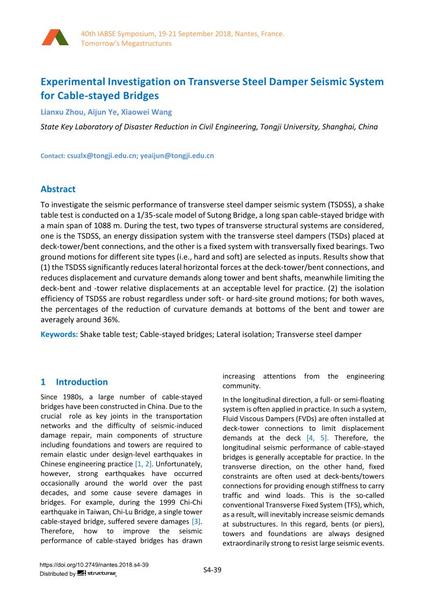Experimental Investigation on Transverse Steel Damper Seismic System for Cable-stayed Bridges

|
|
|||||||||||
Détails bibliographiques
| Auteur(s): |
Lianxu Zhou
(State Key Laboratory of Disaster Reduction in Civil Engineering, Tongji University, Shanghai, China)
Aijun Ye (State Key Laboratory of Disaster Reduction in Civil Engineering, Tongji University, Shanghai, China) Xiaowei Wang (State Key Laboratory of Disaster Reduction in Civil Engineering, Tongji University, Shanghai, China) |
||||
|---|---|---|---|---|---|
| Médium: | papier de conférence | ||||
| Langue(s): | anglais | ||||
| Conférence: | IABSE Symposium: Tomorrow’s Megastructures, Nantes, France, 19-21 September 2018 | ||||
| Publié dans: | IABSE Symposium Nantes 2018 | ||||
|
|||||
| Page(s): | S4-39 | ||||
| Nombre total de pages (du PDF): | 8 | ||||
| DOI: | 10.2749/nantes.2018.s4-39 | ||||
| Abstrait: |
To investigate the seismic performance of transverse steel damper seismic system (TSDSS), a shake table test is conducted on a 1/35-scale model of Sutong Bridge, a long span cable-stayed bridge with a main span of 1088 m. During the test, two types of transverse structural systems are considered, one is the TSDSS, an energy dissipation system with the transverse steel dampers (TSDs) placed at deck-tower/bent connections, and the other is a fixed system with transversally fixed bearings. Two ground motions for different site types (i.e., hard and soft) are selected as inputs. Results show that (1) the TSDSS significantly reduces lateral horizontal forces at the deck-tower/bent connections, and reduces displacement and curvature demands along tower and bent shafts, meanwhile limiting the deck-bent and -tower relative displacements at an acceptable level for practice. (2) the isolation efficiency of TSDSS are robust regardless under soft- or hard-site ground motions; for both waves, the percentages of the reduction of curvature demands at bottoms of the bent and tower are averagely around 36%. |
||||
| Mots-clé: |
Ponts à haubans
|
||||
